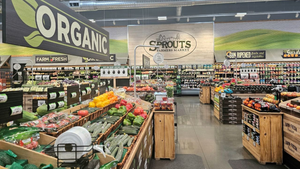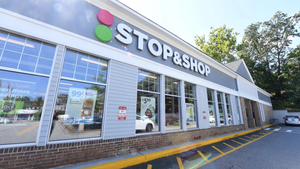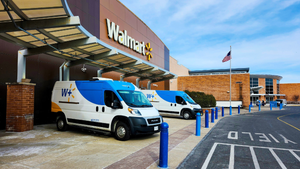THE RIGHT MOVESTHE RIGHT MOVES
While taking a chance on new technology can make some supermarket executives cringe, that is not the case with these leaders.They're willing to test new technology for self-checkout because they envision the payback in increased profits and pleased customers. They've aggressively pursued a new warehouse management system because it will ultimately mean that the right product hits the stores at the
December 13, 1999
PATRICK SCIACCA / KIM ANN ZIMMERMANN
While taking a chance on new technology can make some supermarket executives cringe, that is not the case with these leaders.
They're willing to test new technology for self-checkout because they envision the payback in increased profits and pleased customers. They've aggressively pursued a new warehouse management system because it will ultimately mean that the right product hits the stores at the right time.
Here are some of the standouts when it comes to applying technology in the store and throughout the supply chain.
U-Check Speeds the Self-Checkout Experience
SALEM, Utah -- U-Check supermarket here uses biometrics to speed up the self-checkout process.
The supermarket opened a completely self-checkout supermarket several months ago, and plans to open several more in the next six months.
"We're tackling several things at once with technology," said Randy Johnson, vice president, marketing for the supermarket. "We're addressing the labor shortage and improving the shopping experience."
Customers are issued a magnetic strip card that is used to store their fingerprint image as well as name and checking account information. When the customer has completed scanning the items, they scan their fingerprint using a small device connected to the point-of-sale system. If the fingerprint scanned at the POS matches the fingerprint on the card, the amount of the order is charged to their checking account.
The 25,000-square-foot U-Check supermarket operates with about 18 people, including two cashiers who monitor customers as they check out their groceries, a far cry from the 50 or 60 people typically needed to staff a supermarket of that size.
Bashas' POS Enables Flexible Frequent Shopper Deals
CHANLDER, Ariz. -- Bashas' new point-of-sale system will enable the retailer to be more flexible with frequent shopper offers, among other benefits.
"For example, instead of offering everyone who buys dog food a discount, we could offer a discount to people who buy dog food and have a baby," noted Larry Simpson, director of information technology for the chain. "We can put together much more complex of an offer, which is the goal of a good frequent shopper program," he stated.
The chain initiated its first frequent shopping program in October 1998 and has more than one million customers using the program, company officials said.
"[The POS] provides the functionality, flexibility, usability and power to conduct quick-time shopping transactions for our customers and optimize our frequent shopping program."
Ralph's Puts Cart-Mounted Marketing to the Test
COMPTON, Calif. -- Ralphs Grocery Co. here will test a shopping-cart mounted marketing system. The system will be rolled out to 10 test stores beginning in January, according to a source familiar with the project.
As a customer pushes a cart past the units on the shelf, the display unit on the cart is activated and presents a marketing message. Ultimately, the system could be used in conjunction with the supermarket's frequent shopper program to deliver individualized messages and coupons tailored to a customer's shopping history.
"[The system] provides Ralphs' customers with a unique interactive shopping assistant while enabling Ralphs to consolidate and target in-store communications to an all-inclusive marketing system," stated Tom Dahlen, executive vice president of marketing for the retailer.
Features include graphic animated promotional messages, product advertising and a store directory. In addition to receiving specific messages triggered by walking past promoted items, the system also presents customers with a rotating display of product advertising. A sound alerts customers when the message being displayed is activated by their location in the store.
Minyard Expands Warehouse Functionality
COPPELL, Texas -- About two years into developing its third-party provided warehouse management and purchasing system and significantly increasing its productivity, Minyard Food Stores here is taking its efficiency to the next level with the installation of radio frequency technology.
Both the grocery and perishable sections of the retailer's distribution center will utilize the new radio frequency technology, said Jackie Brewer, senior vice president and controller for Minyard, noting that the technology has been in the pilot stage since mid-summer.
Perishable will receive the technology in first of year and about six weeks later grocery will be up and running, according to Brewer. The first phase of the RF phase-in involves installing the technology on forklifts to improve receiving and putaway.
When the product comes in there is a computer module on the fork that tells the employee where to slot the product, as well as instruct the employee to return to the dock with an outbound pallet.
"It will eliminate all the empty pallet travel," Brewer told SN, noting that the new technology will also eliminate the paper pick lists currently used by the retailer.
The cutting edge technology that Minyard is appreciating now comes on the heels of three years of implementation and adjustment.
About three years ago, the retailer revamped its purchasing and warehouse management system. "We were looking [at] better functionality, particularly in purchasing," said Brewer. "We had a legacy system and decided at the same time to install the WMS."
"We're happy with the systems and we did gain in the purchasing area," Brewer told SN. The retailer now has more purchasing history and has computer-assisted ordering decisions, he added
Prior to the new purchasing system, the retailer only had four weeks of history and did most of the purchasing from that data. Now the retailer can reach back 52 weeks and can also access seasonal history as well.
Schnuck Finds SBT Adds Flexibility to Delivery
ST. LOUIS -- Schnuck Markets here is finding that scan-based trading is enabling more flexible delivery schedules to the stores, along with the opportunity to control store labor costs and inventory investment.
"We can now do things based on shelf conditions, rather than relying on some magical forecast," said Bob Drury, vice president of MIS for the 90-plus-store chain. Schnuck's has been testing scan-based trading since the spring, and Drury said the pilot will last until February. He has already seen some positive results, particularly in the service levels to the stores.
He said that SBT has also enabled Schnuck to open up delivery times based on when the stores are open, not when labor is available.
"We have no receiving staff on Sunday. But with SBT, we've eliminated the check-in process. Drivers now have the opportunity to come in any time on the weekends. It is a great opportunity to help both of us -- the retailer and the supplier -- keep the shelves stocked," he noted. "And manufacturers can trade check-in time for merchandising time."
He also noted that SBT enables more flexible route structures for the drivers. "They can even come twice a day if demand warrants," he said, noting that there is no reason point-of-sale data can't be downloaded several times a day.
Scanning accuracy has also improved at the front end, Drury noted. "The cashiers just can't hit $2.95 under the grocer key if something won't scan. You have to take those keys off if you are going to succeed with SBT," he said.
To improve scanning accuracy, suppliers have to improve the quality of UPC symbols as well, he noted. "We're encouraging suppliers to improve the quality of their UPC codes because we replenish the stores based on this information."
H-E-B Leads the Pack in Energy Efficiency
SAN ANTONIO -- H.E. Butt Grocery Co. here has taken energy efficiency to a new level, saving more than $1.5 million energy dollars over the last two years through the use of an infrared thermography camera.
The camera, which can detect equipment defects ranging from electrical to refrigeration, has proven itself a wise investment, according to Kapp Japhet, energy manager, C.E.M, C.E.P., for H-E-B.
Japhet and Jack Gregory, the retailer's two certified infrared thermographers regularly survey the stores as preemptive maintenance measures.
"We can see electrical overloads and electrical maladies [with the camera]. It can tell you temperature differences, as well as see motor problems on compressors, and on the building envelope we can see missing insulation," Kaphet told SN.
The Edison Electric Institute, Washington, D.C., recently honored H-E-B, for its innovative use of the infrared thermography as well as of induction lighting fixtures in walk-in freezers.
The retailer can also locate cold air escaping from its freezers and has utilized the technology to ensure that its cases are refrigerated to the new Food and Drug Administration's 41 Fahrenheit degree requirement.
The infrared tests are run before the retailer takes on a store as well as at the one-year warranty make and when a store reports a problem that the camera can detect.
In addition to early detection, the camera has led to increased awareness from store employees, which has allowed the stores to self-service some of the problems also reducing maintenance costs for the retailer.
Japhet said that the camera, which comes with a price tag of about $65,000 fully loaded, realized the return on investment with the camera's first outing. Japhet and Gregory used the camera to locate what could have been a $100,000 problem in the electrical system at an H-E-B store.
Japhet said the problem was a potential fire hazard.
In addition to the almost $1.5 million saved with the infrared camera, the retailer is realizing another $300,000 in annual energy savings with the implementation of new induction lighting fixtures for all its walk-in freezers.
The induction lighting utilizes an 85-watt bulb that can withstand a temperature of minus 40 degrees Fahrenheit. The bulb is housed in a casing designed for the retailer by a third party.
The light is an instant on, which means it requires no warm-up period like some other low temperature lighting, and one fixture can replace three 100-watt incandescent lights, which also reduces the heat in the room, saving more energy dollars, according to Japhet.
The induction light also has a life span of 100,000 hours, or about 15 years as compared to the 800-hour life span of the more common incandescent light.
"It's a no brainer," Japhet said of the change, which has been taking place over the past two years. "Now you never have to fool with it, and they can last for 15 years."
But, Japhet said the retailer is continually looking for new ways to improve energy efficiency and is in the process of changing all of its stores 400-watt metal halide lighting to 350-watt lighting. The change represents a saving of 50 watts per fixture, Japhet said.
The sales' floor lighting is also being modified from a T12 lighting system to the smaller diameter and more energy efficient T8 lighting system.
Japhet said that those two initiatives should result in an additional $3 million in energy savings as well.
About the Author
You May Also Like
.webp?width=300&auto=webp&quality=80&disable=upscale)



